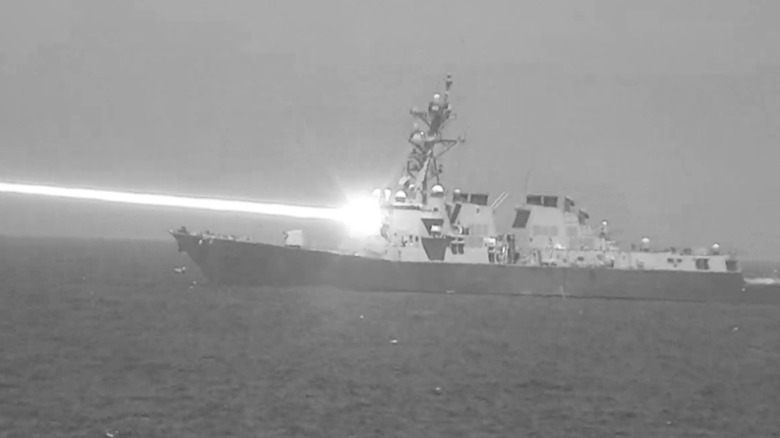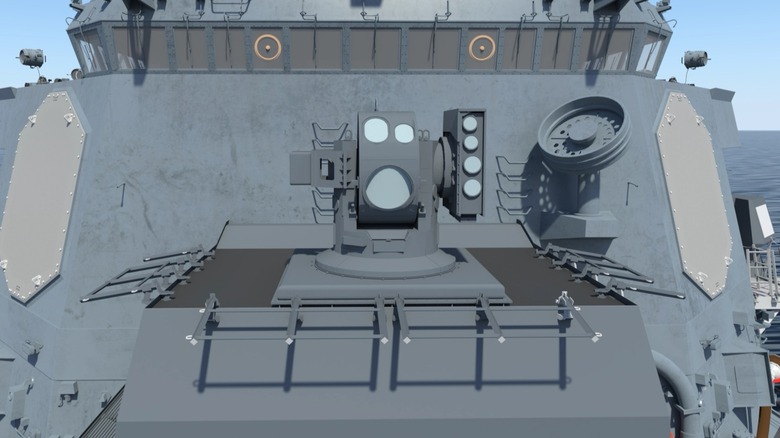The US Navy's New Military Laser Successfully Shoots Drones Out Of The Sky
Ever since lasers were invented in 1960, defense contractors and servicemembers have dreamed of shooting things out of the sky with them. Lasers are used all the time in targeting, from the attachments on firearms to laser-painting a target for bombing, but the laser isn't the weapon. That's finally changing, though. The Army's high energy laser program is moving forward, and the U.S. Navy has been testing its HELIOS system on the USS Preble (DDG 88).
The Navy's High Energy Laser and Integrated Optical-dazzler with Surveillance system isn't about shooting targets on the shore from the sea. Instead, it's an active missile, rocket, and artillery defense system. Current defense systems fire interceptor missiles at incoming fire; the Navy's computer-controlled Phalanx CIWS system sprays armor-piercing or high-explosive incendiary rounds into the sky to take out a close-in threat. HELIOS eschews these traditional means of air defense for a more photonic system that can shoot enemies out of the sky.
The HELIOS system has been in development since 2018, and in fiscal year 2024, it was used to shoot target drones. If you're wondering why the Navy would dump the tried and true methods of hitting incoming targets, the answer is simple: cost. Firing a laser costs almost nothing compared to the cost of procuring, maintaining, and firing traditional ordnance, and once perfected, the HELIOS will be more accurate, making it an ideal choice for future close-in defense.
What HELIOS brings to the table
HELIOS was first installed as a 60-plus-kilowatt laser in August 2022, making it the first high-energy tactical laser system on a U.S. naval vessel. As drone warfare becomes more prominent, lasers like the HELIOS are becoming more important to the Navy and other services. After all, firing a far less expensive laser is better than destroying an unmanned aerial system that costs a few thousand dollars with a $100,000 — or more — rocket.
At the end of the day, warfare is as much economics as anything else, and HELIOS will help keep the Navy in the black. While HELIOS was initially set to 60 kW, it will eventually hit 150 kW, though this isn't enough energy to destroy an incoming anti-ship cruise missile. The power output would likely need to be in the 300-to-500 kW range for that. Until HELIOS is given the needed boost, it's proven itself capable of destroying military drones up to five miles away from the ship.
Of course, this was only a test to prove HELIOS' validity, and isn't necessarily demonstrative of its final capabilities once it's upgraded. The test, as outlined in the Director, Operational Test & Evaluation report, was meant to verify HELIOS' performance and abilities. The laser aboard the Preble accomplished this, so with further testing, it's possible that the Navy's current close-in weapons system will be swapped out for tactical lasers, or at least be augmented by them.
The future of U.S. Navy laser defensive systems
HELOIS' successful test was but one small step in the Navy's plan to develop a multitude of laser systems for shipboard defense. Navy budget documents for FY25 indicate that HELIOS will next attempt to strike an inbound anti-ship cruise missile. Of course, the U.S. military rarely puts all of its grenades in a single satchel, so it's developing a plethora of powerful laser systems.
The High Energy Laser Counter Anti-Ship Cruise Missile Project, known as HELCAP, will bring 300+ kW of power to bear. For comparison, a laser pointer used by sailors briefing their commander is typically around one mW, or 300 million times less powerful. The higher the energy output, the shorter the necessary time on target to destroy or destabilize incoming ordnance, so improving this helps increase the system's efficacy. In 2020, it took 15 seconds for a 30 kW laser to destroy a drone, so reducing that time would improve the system and better secure whatever ship it defends.
Meanwhile, the Optical Dazzling Interdictor, Navy, known as ODIN, doesn't try to destroy a drone, instead focusing on taking out its sensors. All of these tactical lasers offer greater accuracy and lethality while costing significantly less than legacy systems. These are the primary reasons the Navy has been clamoring for laser defenses for so long, and they're finally beginning to arrive, albeit slowly and with a great deal of testing.


